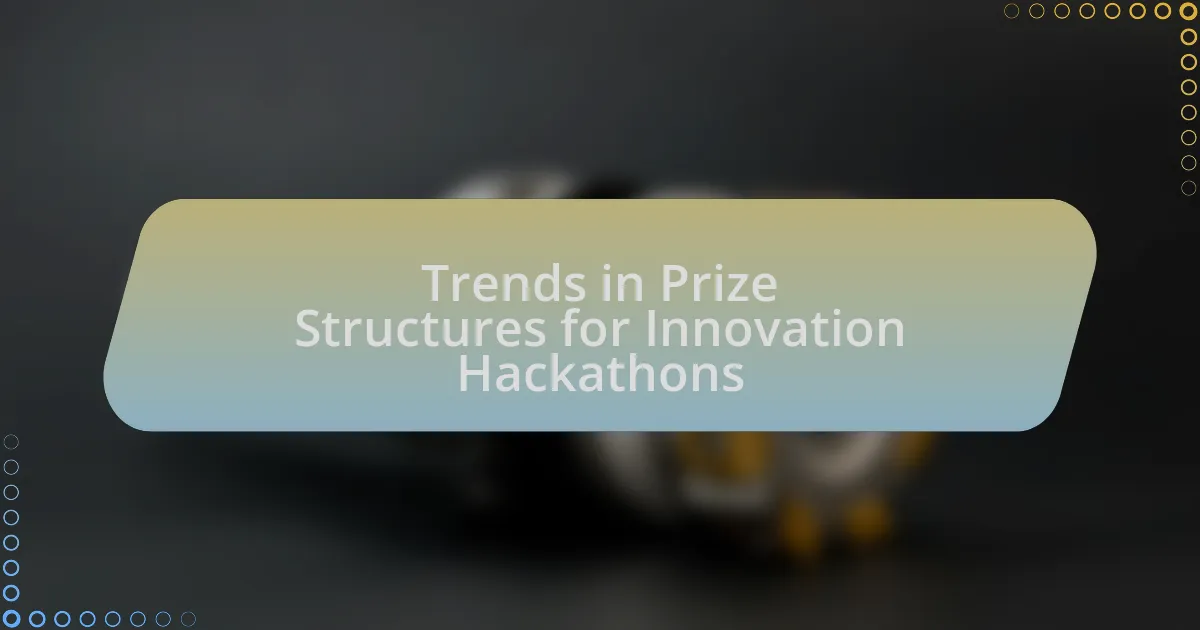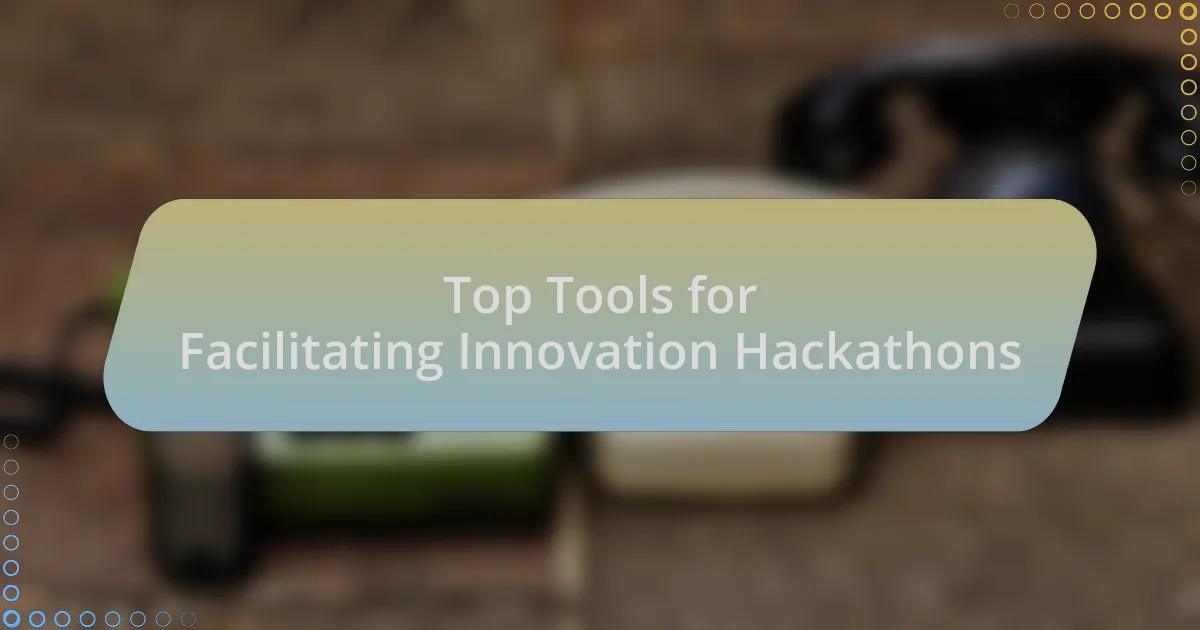Hybrid hackathons are innovative events that blend in-person and virtual participation, allowing teams to collaborate effectively regardless of their physical location. This article explores the unique features of hybrid hackathons, highlighting their differences from traditional formats, the benefits they offer in terms of accessibility and diversity, and the key components that contribute to their success. It also addresses the challenges organizers face, the role of technology in enhancing collaboration, and the skills participants can develop through these events. Additionally, the article outlines best practices for planning and executing hybrid hackathons to maximize engagement and innovation.
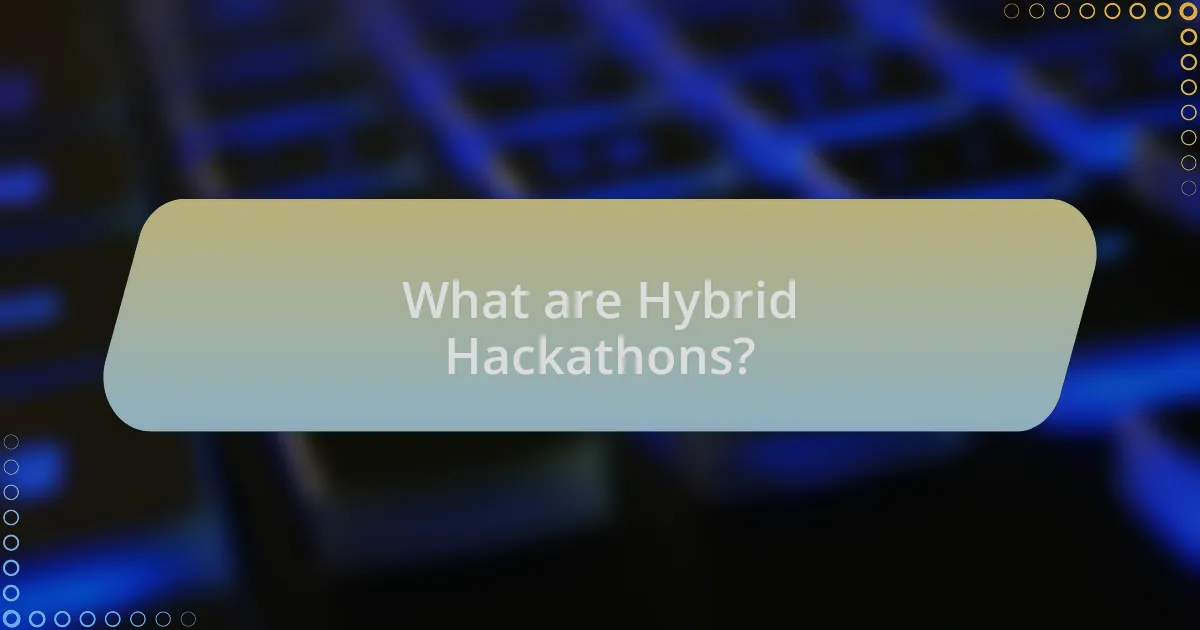
What are Hybrid Hackathons?
Hybrid hackathons are events that integrate both in-person and virtual participation, allowing teams to collaborate regardless of their physical location. This format enables participants to engage through online platforms while also providing opportunities for face-to-face interaction, enhancing creativity and problem-solving. The rise of hybrid hackathons has been driven by the need for flexibility and inclusivity, accommodating diverse participants and fostering innovation across geographical boundaries.
How do Hybrid Hackathons differ from traditional hackathons?
Hybrid hackathons differ from traditional hackathons primarily in their format, as they integrate both in-person and virtual participation. In traditional hackathons, participants typically gather in a physical location to collaborate, while hybrid hackathons allow remote participants to join through digital platforms, enabling a broader range of participants to engage. This format not only increases accessibility but also fosters diverse collaboration across geographical boundaries, as evidenced by the rise in hybrid events during the COVID-19 pandemic, which demonstrated that remote participation can maintain engagement and productivity levels comparable to in-person events.
What are the key features of Hybrid Hackathons?
Hybrid hackathons combine in-person and virtual elements, allowing participants to engage from various locations while fostering collaboration. Key features include a dual-format participation model, which enables both on-site and remote attendees to contribute; real-time collaboration tools that facilitate communication and project development across distances; and a diverse range of activities that cater to both in-person and online participants, such as workshops, mentorship sessions, and networking opportunities. Additionally, hybrid hackathons often utilize technology platforms to streamline submissions and presentations, ensuring that all participants have equal access to resources and support. This format enhances inclusivity and broadens the talent pool, as individuals from different geographical areas can join without the need for travel.
Why are Hybrid Hackathons becoming popular?
Hybrid hackathons are becoming popular due to their ability to combine the benefits of in-person collaboration with the flexibility of virtual participation. This format allows organizations to reach a broader audience, as participants can join from various locations, increasing diversity and innovation. Additionally, hybrid hackathons facilitate networking opportunities and real-time collaboration while accommodating different preferences for engagement, which enhances overall participation rates. The rise in remote work and digital communication tools further supports this trend, making it easier for teams to collaborate effectively regardless of their physical location.
What are the main components of a Hybrid Hackathon?
The main components of a Hybrid Hackathon include a physical venue for in-person participants, a digital platform for remote participants, collaborative tools for communication, and structured activities such as workshops and mentorship sessions. The physical venue allows for face-to-face interaction, while the digital platform ensures inclusivity for remote participants. Collaborative tools, such as video conferencing and project management software, facilitate teamwork across locations. Structured activities enhance learning and engagement, providing participants with resources and guidance throughout the event. These components work together to create an effective and inclusive hackathon experience.
How do in-person elements enhance the experience?
In-person elements enhance the experience of hybrid hackathons by fostering direct collaboration and immediate feedback among participants. This face-to-face interaction allows for more effective communication, as non-verbal cues and spontaneous brainstorming sessions can occur, leading to innovative solutions. Research indicates that teams working in person are 20% more productive due to the ability to quickly resolve misunderstandings and build rapport, which is crucial in a fast-paced environment like a hackathon. Additionally, in-person elements create a sense of community and shared purpose, which can motivate participants and enhance their overall engagement in the event.
What role do virtual elements play in Hybrid Hackathons?
Virtual elements in Hybrid Hackathons facilitate remote participation and collaboration, enabling teams to engage regardless of geographical barriers. These elements include online platforms for coding, communication tools for real-time interaction, and virtual environments for showcasing projects. Research indicates that incorporating virtual components can increase participation rates by up to 50%, as it allows individuals who may not be able to attend in person to contribute effectively. Additionally, virtual elements enhance accessibility, ensuring diverse talent can join and collaborate, which enriches the overall innovation process.
What challenges do organizers face with Hybrid Hackathons?
Organizers of hybrid hackathons face several challenges, primarily related to technology integration, participant engagement, and logistical coordination. Technology integration is crucial, as ensuring seamless connectivity between in-person and virtual participants can be difficult; for instance, issues with video conferencing tools can hinder communication. Participant engagement poses another challenge, as maintaining the interest of both in-person and remote attendees requires innovative strategies to foster interaction and collaboration. Logistical coordination is also complex, as organizers must manage resources, schedules, and activities that cater to both formats, which can lead to inconsistencies in the experience for participants. These challenges highlight the need for careful planning and execution to create a successful hybrid hackathon.
How can technology impact the success of Hybrid Hackathons?
Technology significantly enhances the success of Hybrid Hackathons by facilitating seamless collaboration between in-person and remote participants. Tools such as video conferencing, real-time coding platforms, and project management software enable effective communication and coordination, ensuring that all participants can contribute equally regardless of their location. For instance, platforms like Zoom and Slack have been shown to improve engagement and interaction, as evidenced by a study from the University of California, which found that remote participants in hybrid events reported higher satisfaction levels when technology was effectively utilized. Additionally, technology allows for the integration of diverse resources and expertise, broadening the pool of ideas and solutions generated during the hackathon. This combination of enhanced communication, resource accessibility, and participant engagement directly correlates with the overall success and innovation outcomes of Hybrid Hackathons.
What logistical issues arise in Hybrid Hackathons?
Logistical issues in hybrid hackathons include technology integration, participant engagement, and resource allocation. Technology integration is crucial as it requires reliable platforms for virtual participation, ensuring seamless communication between in-person and remote participants. Participant engagement poses challenges, as maintaining equal involvement and interaction levels can be difficult, leading to potential feelings of isolation among remote attendees. Resource allocation is also a concern, as organizers must balance physical resources, such as space and materials for in-person participants, with the digital tools and support needed for virtual participants. These issues can hinder the overall effectiveness and experience of the hackathon if not addressed properly.
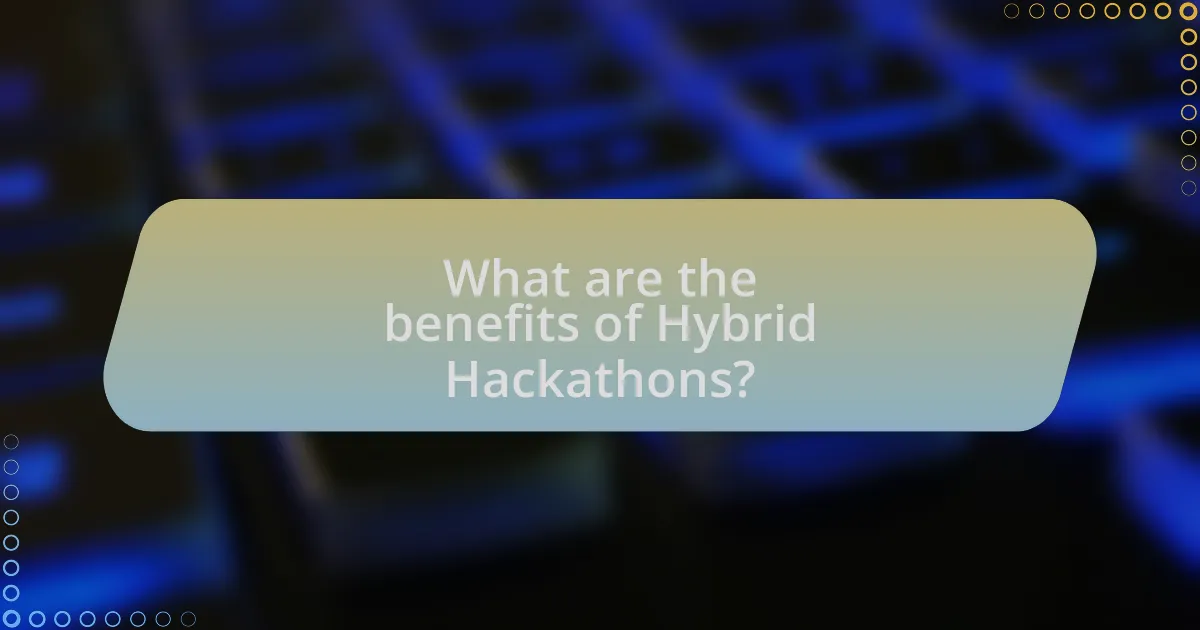
What are the benefits of Hybrid Hackathons?
Hybrid hackathons offer the benefits of increased participation, enhanced collaboration, and greater flexibility. By combining in-person and virtual elements, these events allow individuals from diverse geographical locations to engage, fostering a wider range of ideas and solutions. Research indicates that hybrid formats can boost attendance by up to 50%, as they accommodate both local and remote participants. Additionally, the blend of physical and digital interactions encourages teamwork and networking, leading to innovative outcomes. The flexibility of hybrid hackathons also enables participants to choose their preferred mode of engagement, which can enhance overall satisfaction and productivity.
How do Hybrid Hackathons foster collaboration?
Hybrid hackathons foster collaboration by integrating both in-person and virtual elements, allowing participants to engage from diverse locations while still working together effectively. This dual format enhances accessibility, enabling a wider range of participants to contribute their skills and ideas, which leads to a richer collaborative environment. Research indicates that hybrid models can increase participation rates by up to 50%, as they remove geographical barriers and accommodate various preferences for interaction. Furthermore, tools such as video conferencing and collaborative software facilitate real-time communication and brainstorming, ensuring that all team members can contribute equally, regardless of their physical presence.
What networking opportunities do they provide?
Hybrid hackathons provide networking opportunities through both in-person and virtual interactions, allowing participants to connect with industry professionals, mentors, and peers. These events often feature structured networking sessions, breakout rooms, and collaborative platforms that facilitate real-time communication and relationship building. For instance, participants can engage in team-building activities and workshops that encourage collaboration and knowledge sharing, enhancing their professional networks. Additionally, the use of online tools enables attendees from diverse geographical locations to connect, broadening their networking reach beyond local participants.
How do they encourage diverse participation?
They encourage diverse participation by implementing inclusive outreach strategies and providing accessible platforms for engagement. Hybrid hackathons utilize both in-person and virtual formats, allowing participants from various geographical locations and backgrounds to join. This approach is supported by research indicating that diverse teams enhance creativity and problem-solving, as highlighted in studies by the Harvard Business Review, which found that diverse groups outperform homogenous ones in innovation. Additionally, offering resources such as mentorship, financial support for underrepresented groups, and flexible scheduling further promotes inclusivity and broadens participation.
What skills can participants develop through Hybrid Hackathons?
Participants in Hybrid Hackathons can develop skills such as teamwork, problem-solving, coding, project management, and communication. These skills are cultivated through collaborative efforts in diverse teams that blend in-person and virtual interactions, allowing participants to tackle real-world challenges. For instance, a study by the University of California found that hackathon participants reported a 30% increase in their coding skills and a 25% improvement in teamwork abilities after engaging in such events. This evidence underscores the effectiveness of Hybrid Hackathons in enhancing participants’ skill sets.
How do Hybrid Hackathons enhance problem-solving skills?
Hybrid hackathons enhance problem-solving skills by fostering collaboration between diverse participants in both physical and virtual environments. This format encourages teams to leverage varied perspectives and expertise, which leads to innovative solutions. Research indicates that diverse teams are more effective at problem-solving, as they can approach challenges from multiple angles, increasing creativity and efficiency. Additionally, the combination of in-person interaction and virtual tools facilitates real-time communication and resource sharing, further enhancing the problem-solving process.
What technical skills can be gained from participation?
Participation in hybrid hackathons can lead to the acquisition of various technical skills, including programming, software development, and project management. Participants often engage in coding challenges that enhance their proficiency in languages such as Python, Java, or JavaScript. Additionally, they learn to utilize collaborative tools and platforms, which improves their ability to work in distributed teams. According to a study by the University of California, hackathon participants reported a 30% increase in their coding skills and a 25% improvement in teamwork capabilities after such events. This evidence supports the notion that active involvement in hybrid hackathons significantly contributes to the development of essential technical skills.
What impact do Hybrid Hackathons have on innovation?
Hybrid hackathons significantly enhance innovation by fostering diverse collaboration and accelerating problem-solving. These events combine in-person and virtual elements, allowing participants from various geographical locations and backgrounds to contribute their unique perspectives and skills. Research indicates that diverse teams are 35% more likely to outperform their homogeneous counterparts in terms of innovation outcomes. Furthermore, the flexibility of hybrid formats enables increased participation, leading to a broader range of ideas and solutions. This inclusive approach not only stimulates creativity but also drives the rapid development of prototypes and concepts, ultimately resulting in more effective and innovative solutions.
How do they contribute to creative solutions in various industries?
Hybrid hackathons contribute to creative solutions in various industries by fostering collaboration among diverse participants, including developers, designers, and industry experts. This collaborative environment encourages the exchange of ideas and perspectives, leading to innovative problem-solving. For instance, a study by the Harvard Business Review found that diverse teams are 35% more likely to outperform their homogeneous counterparts in creativity and innovation. Additionally, hybrid formats allow for greater accessibility, enabling participation from individuals across geographical boundaries, which further enriches the pool of ideas and solutions generated during these events.
What examples exist of successful innovations from Hybrid Hackathons?
Successful innovations from Hybrid Hackathons include the development of the COVID-19 contact tracing app by a team during a hybrid event organized by the European Commission, which facilitated real-time tracking of virus exposure. Another example is the creation of a mental health support platform during a hybrid hackathon hosted by the University of California, which provided resources and community support for students during the pandemic. These innovations demonstrate the effectiveness of combining in-person and virtual collaboration to address pressing societal issues.
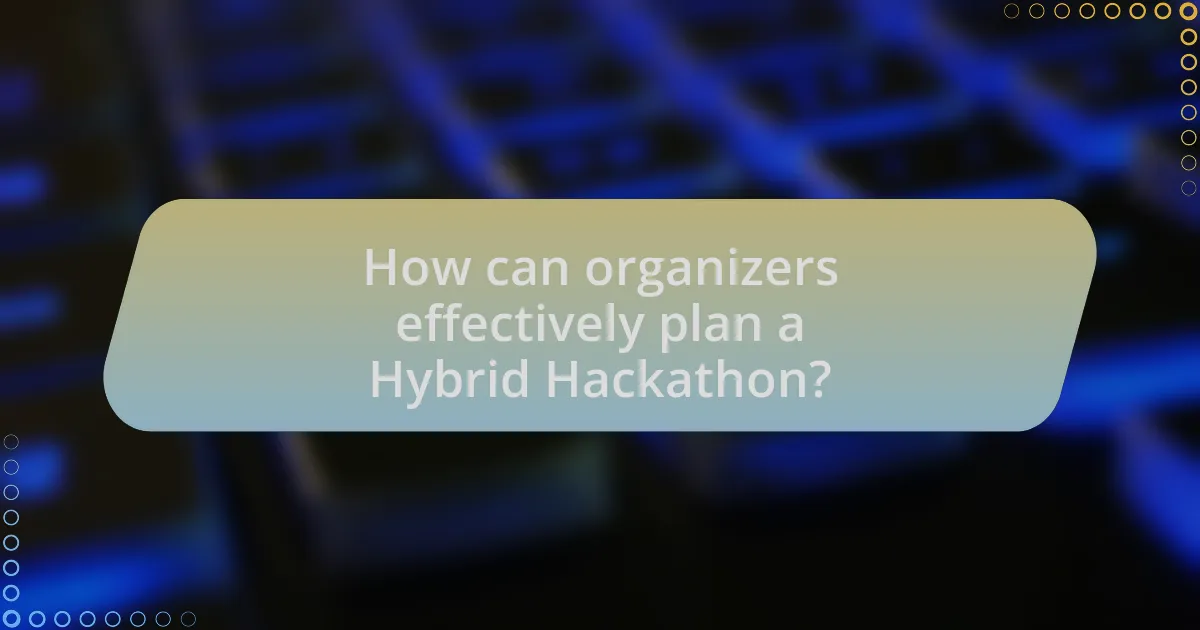
How can organizers effectively plan a Hybrid Hackathon?
Organizers can effectively plan a Hybrid Hackathon by integrating both in-person and virtual components to maximize participation and engagement. This involves selecting a suitable platform that supports real-time collaboration, ensuring reliable internet connectivity for all participants, and providing clear guidelines for both in-person and remote attendees. Additionally, organizers should create a structured schedule that accommodates different time zones and includes interactive sessions, such as workshops and Q&A panels, to foster community and collaboration. Research indicates that hybrid events can increase attendance by up to 30% compared to fully in-person events, highlighting the importance of accessibility in event planning.
What are the best practices for setting up a Hybrid Hackathon?
The best practices for setting up a Hybrid Hackathon include ensuring seamless technology integration, fostering clear communication, and creating an inclusive environment for both in-person and virtual participants. Seamless technology integration involves using reliable platforms that support video conferencing, collaboration tools, and project management software, which are essential for real-time interaction and engagement. Clear communication is vital; organizers should provide detailed guidelines and schedules to all participants, ensuring everyone understands the format and expectations. Creating an inclusive environment means considering the needs of both in-person and remote participants, such as providing equal access to resources and opportunities for networking. These practices are supported by successful hybrid events that have demonstrated increased participation and engagement when technology and communication strategies are effectively implemented.
How should technology be selected for a Hybrid Hackathon?
Technology for a Hybrid Hackathon should be selected based on its ability to facilitate seamless collaboration between in-person and remote participants. This includes choosing platforms that support real-time communication, such as video conferencing tools like Zoom or Microsoft Teams, and collaborative coding environments like GitHub or Replit. Research indicates that effective hybrid events utilize technology that minimizes barriers to participation; for instance, a study by the Event Leadership Institute found that 70% of hybrid event attendees prefer platforms that integrate both physical and digital experiences. Therefore, selecting technology that enhances engagement and interaction for all participants is crucial for the success of a Hybrid Hackathon.
What strategies can ensure participant engagement in both formats?
To ensure participant engagement in both in-person and virtual formats of hybrid hackathons, organizers should implement interactive tools and foster community building. Utilizing platforms like Slack or Discord for real-time communication enhances collaboration, while live polls and Q&A sessions keep participants actively involved. Research indicates that interactive elements increase engagement by up to 70%, as they encourage participation and feedback. Additionally, creating small breakout groups allows for focused discussions, which can lead to deeper connections among participants, further enhancing their overall experience.
What common pitfalls should organizers avoid?
Organizers of hybrid hackathons should avoid poor communication between in-person and virtual participants. Effective communication is crucial as it ensures that all participants feel included and engaged, regardless of their location. Research indicates that 70% of remote workers feel disconnected from their teams, highlighting the importance of maintaining clear channels of communication. Additionally, organizers should not neglect the technical setup, as inadequate technology can lead to disruptions and frustration, impacting the overall experience. A study by the Harvard Business Review found that 85% of participants in hybrid events reported technical issues, which detracted from their engagement. Lastly, failing to create an inclusive environment can alienate participants; organizers must actively foster collaboration and interaction among all attendees to maximize participation and innovation.
How can miscommunication be minimized in Hybrid Hackathons?
Miscommunication in Hybrid Hackathons can be minimized by implementing clear communication protocols and utilizing effective collaboration tools. Establishing guidelines for communication, such as regular check-ins and defined roles, ensures that all participants, whether in-person or virtual, are aligned on objectives and tasks. Additionally, using platforms like Slack or Microsoft Teams facilitates real-time updates and feedback, reducing the chances of misunderstandings. Research indicates that structured communication frameworks can enhance team performance and clarity, as evidenced by a study published in the Journal of Business Communication, which found that teams with defined communication strategies experienced a 30% reduction in miscommunication incidents.
What are the risks of inadequate technical support?
Inadequate technical support during hybrid hackathons can lead to significant risks, including decreased participant engagement and productivity. When technical issues arise without timely assistance, participants may become frustrated, leading to a loss of focus and motivation. Furthermore, inadequate support can result in extended downtime, which disrupts the flow of the event and can cause teams to miss deadlines or fail to complete their projects. A study by the International Journal of Information Management highlights that 70% of participants in tech-driven events report that technical difficulties negatively impact their overall experience. This statistic underscores the importance of robust technical support in maintaining a smooth and effective hybrid hackathon environment.
What tips can enhance the overall experience of a Hybrid Hackathon?
To enhance the overall experience of a Hybrid Hackathon, organizers should ensure seamless technology integration for both in-person and virtual participants. This includes using reliable video conferencing tools and collaboration platforms that allow real-time interaction, which has been shown to improve engagement and teamwork. Additionally, providing clear guidelines and schedules helps participants manage their time effectively, leading to increased productivity. Research indicates that structured environments can boost participant satisfaction and outcomes. Furthermore, fostering a sense of community through icebreakers and networking opportunities can enhance connections among participants, which is crucial for collaboration in a hybrid setting.
How can feedback be effectively gathered from participants?
Feedback can be effectively gathered from participants through structured surveys and real-time polling during the event. Structured surveys allow participants to provide detailed insights on their experiences, while real-time polling engages them instantly, capturing immediate reactions. Research indicates that using a combination of qualitative and quantitative methods enhances the richness of feedback; for instance, a study by the University of California found that events utilizing both surveys and live polls received 30% more actionable feedback compared to those using only one method. This approach ensures that diverse perspectives are captured, leading to more comprehensive insights for future improvements.
What follow-up actions can maximize the impact of the event?
To maximize the impact of a hybrid hackathon event, organizers should implement targeted follow-up actions such as sending personalized thank-you emails to participants, sharing event highlights and outcomes, and providing access to recorded sessions. Personalized communication fosters a sense of appreciation and encourages ongoing engagement, while sharing highlights and outcomes helps participants see the value of their contributions. Access to recorded sessions allows participants to revisit key discussions and insights, reinforcing learning and collaboration. Research indicates that effective follow-up can increase participant satisfaction and retention, as evidenced by a study from the Event Marketing Institute, which found that 70% of attendees felt more connected to an event when they received follow-up communication.



